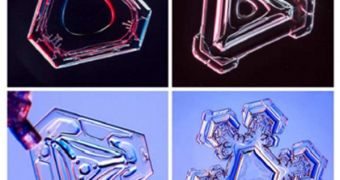One of the most commonly known traits of snowflakes is the fact that they are hexagonal. Even pre-school children can tell you this, and their properties as such have been exhaustively investigated over the years. But, commonly, scientists discover that the frozen water falling from the sky is actually shaped like a triangle, which raises a number of questions as to the phenomena that are at work to create this effect. The real mystery is why is the triangle the second most preferred shape after the hexagonal one, and not, for example, a square, or a diamond-like structure, Technology Review reports.
According to existing knowledge, the snowflakes take up their usual, six-sided shape on account of the hydrogen bonds that exist between the chemicals making them up, hydrogen and oxygen. It may be that other shapes only appear when the the crystal growth process is disturbed during one of its stages. At least in theory, shapes such as diamonds, squares and rectangles are also possible, yet triangles seem to dominate the second most popular snowflake category. Scientists have been wondering why for years.
A possible answer to this riddle is currently being provided by Kenneth Libbrecht, who is an expert at the California Institute of Technology (Caltech), in Pasadena, California. The scientist is not on his first encounter with snowflakes. He is responsible for a previous research, during which he and his colleagues constructed a machine that was capable of producing artificial water crystals, which then the group studied extensively. The expert has discovered that the two main processes governing over snowflake formation are the diffusion of water molecules and the molecular dynamics on the surface of the crystals themselves.
Libbrecht says that one of the most important factors capable of influencing the way ice crystals form is the aerodynamic environment in which the structure develops. The crystals' growth rates are determined to a great extent by their orientations as they fall, as well as by the ventilation they are subjected to. The scientist also calculated that small perturbations on the sides of the crystal were also responsible for altering the growth process, and ultimately the shape. In the case of triangular snowflakes, the expert has determined that this type of structure is impervious to the latter type of changes. This accounts for why they are able to retain their shape most of the time.

 14 DAY TRIAL //
14 DAY TRIAL //